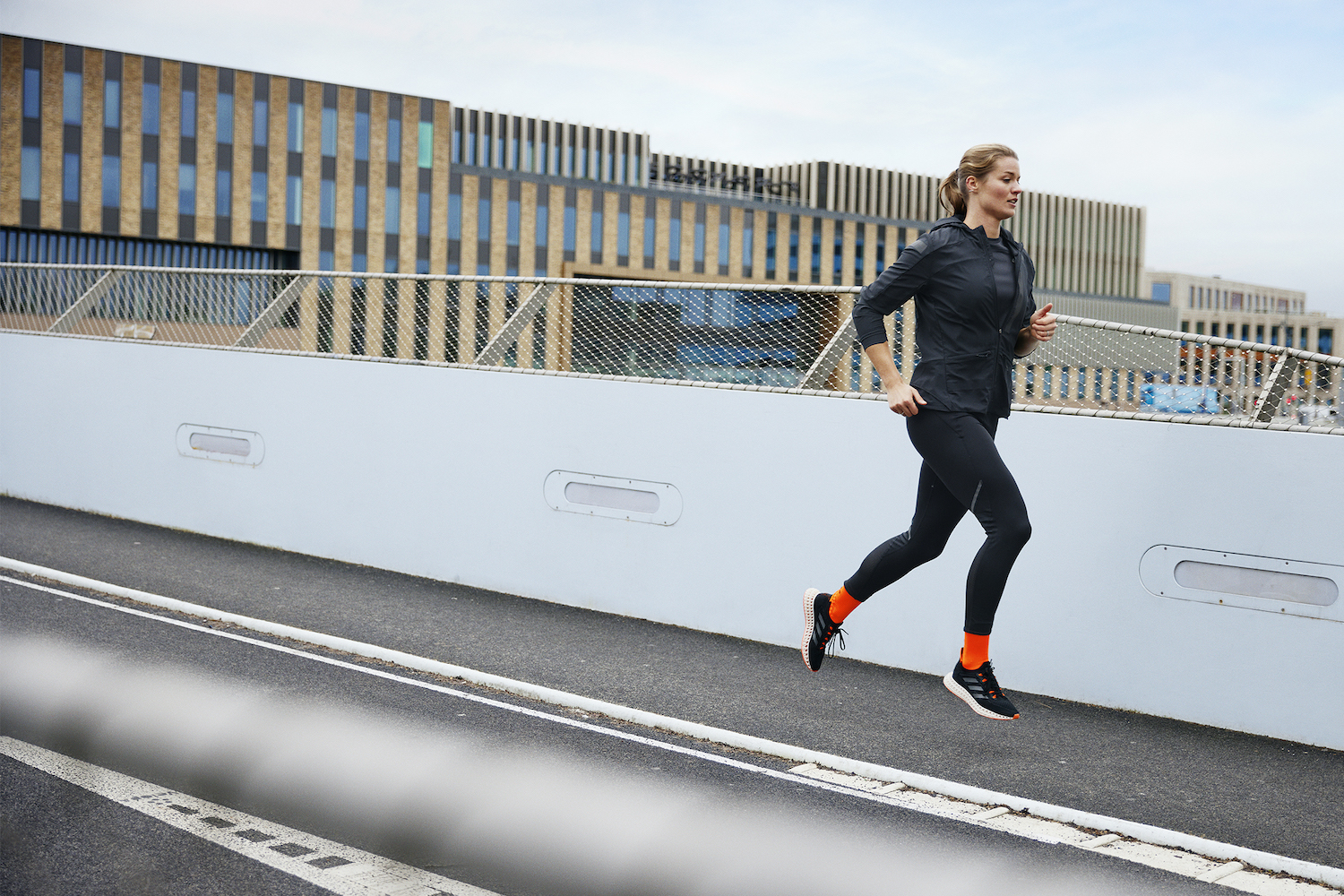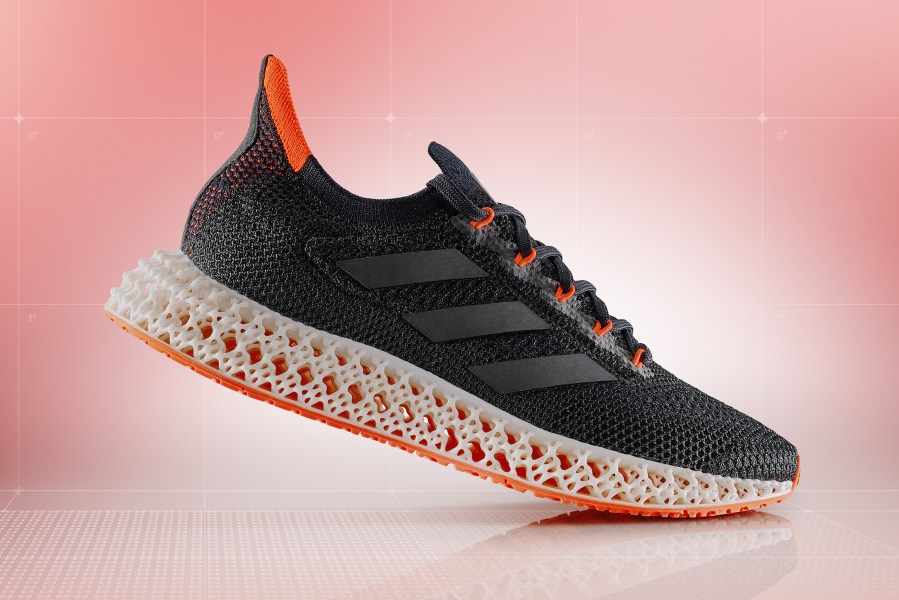Does it deliver? Women’s Fitness writer, Joanna Ebsworth, puts these new runners to the test and gets some unexpected results…
Some people are natural born runners. I am not one of them.
For as long as I can remember, running has always felt labour-intensive, uncomfortable and (*whisper it*) unnatural to me. Stick me in a dance, spinning or HIIT class and I can go for hours. Ask me to jog for two minutes to the bus stop and I’m a physical wreck.
So, after decades of trying – and failing miserably – to reap the benefits of pavement pounding, it is no small miracle for me to report that a new shoe has finally helped me to fall in love with running.
The shoe in question is the new adidas 4DFWD. What makes it so special? Read on to find out…
The first test run
I took delivery of my 4DFWDs a month before the May 5th launch date to put them through their paces. What I didn’t receive was a single bit of accompanying information to tell me what made them so exceptional. This is highly unusual, but on this occasion, it seems adidas were happy to let the shoes do all the talking.
And I’m not surprised. After walking around in the 4DFWDs for the first time, my initial feelings were that I had two memory foam mattresses strapped to my feet. I jumped up and down, walked back and forth, and concluded that these were the springiest, bounciest, dreamiest things I’d ever had on my feet. Taking them off to investigate further, I pressed and prodded at the soles to examine their unusual construction, watching in wonder as the material compressed quite dramatically under force and instantly sprang back into shape when the pressure was released.
Wanting to understand how this technology would translate into running, I excitedly took them out for a spin. The experience was mind blowing to say the least, and I am happy to report that running has continued to be a breeze for me ever since; a fact that I can confidently attribute to the shoe. Let me count the ways…

The 4D lattice midsole construction was identified from one of five million possible structures
Here comes the science…
First up, let’s talk about the midsole. Over four years in the making, the 4DFWD midsole is the result of a partnership between adidas and Carbon that utilises cutting-edge 3D printing performance technology to produce a midsole that literally propels the runner forward. The 4D lattice midsole construction that we see in the 4DFWDs today was identified from one of five million possible lattice structures, and the final, highly unique bow-tie-shaped FWD CELL has been specifically coded to compress forwards upon vertical impact. The result? When compared to previous generations of 4D midsoles, the adidas 4DFWD generates three times as much forward motion under vertical loading in mechanical testing conditions.
An additional bonus of this construction means that the ‘peak braking force’ experienced by runners is reduced on average by 15 per cent, because the midsole redirects the vertical impact forces into horizontal forward motion. What does this mean in layman’s terms? Well, put simply, it means that running becomes a far more comfortable, easy and enjoyable experience.
For me, the reduction of ‘brake force’ meant that I barely felt my heel striking the ground, and the resulting rolling action through the entirety of my foot to the toe-off was incredibly smooth. Generally, I would describe the action of my feet while running as quite jerky: my heel makes contact with the ground; my foot plate slaps to the floor; and it takes a lot of effort to push off from the toes. But with the 4DFWDs on my feet, I feel as though I’m finally getting to experience what I’ve heard so many other runners talk about when they mention ‘smooth transitions’, ‘gliding sensations’ and that feeling of ‘forward propulsion’. Suddenly, running really has become easier, vastly more comfortable, and less cumbersome. I also feel like I’m actually getting somewhere. And for me, that is everything.

Elite sprinter Dafne Schippers takes the adidas 4DFWDs for a run
All about the impact
Aside from the cold hard facts from adidas – including data that says cushioning is improved by a whopping 23 per cent – the brand barely makes a claim about the 4DFWDs in terms of how they could improve your running, help you go faster for longer, reduce the risk of injury or improve your PB. adidas simply asserts that the shoe offers an ‘all-new running experience’.
Neither do the shoe designers tell me what kind of runner the trainer is aimed at when I ask via Zoom. Weighing in at 333g, it’s certainly not a racing shoe (although something about it feels seriously lightweight when on the feet). And, in an age where gender-specific designs are deemed essential for maximum performance, the 4DFWD is, surprisingly, unisex. But this isn’t a problem, according to the designers, because the shoe has been constructed with years of male and female athlete biomechanic data, so it provides all runners with the individual support and comfort they need.
Indeed, both male and female athletes have been testing the adidas 4DFWD shoes in the run up to the Tokyo Olympics, including South African 400m World Record holder, Wayde van Niekerk – ‘it looks and feels great and provides the perfect mix of comfort and performance in my training runs’ – and Dutch 200m sprinter Dafne Schippers – ‘you can really experience the gliding sensation and forward motion’.
I’m no professional athlete, and I can’t tell you if this shoe makes me run faster, but what I can tell you is that running is now a completely pleasurable and exciting experience for me with the adidas 4DFWDs on my feet. My ankles, knees and hips don’t hurt with every step; I’m enjoying the possibilities of where running can take me and, for the first time, I feel like I’m finally part of ‘the club’. And if that’s not an ‘all-new running experience’, I’m not sure what is.







